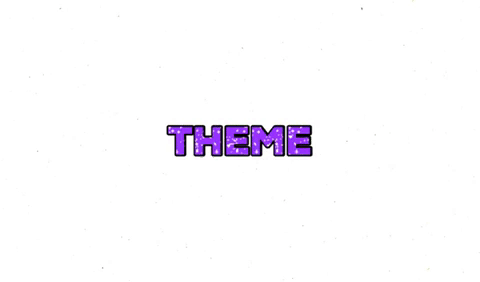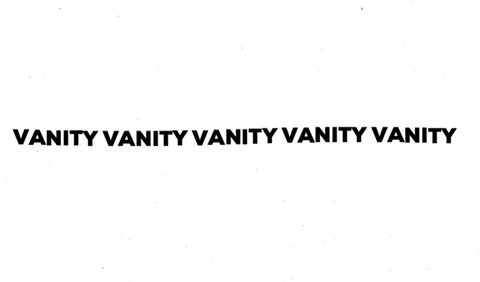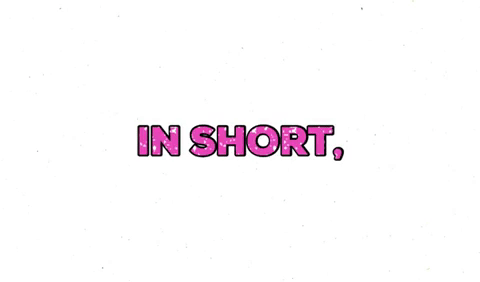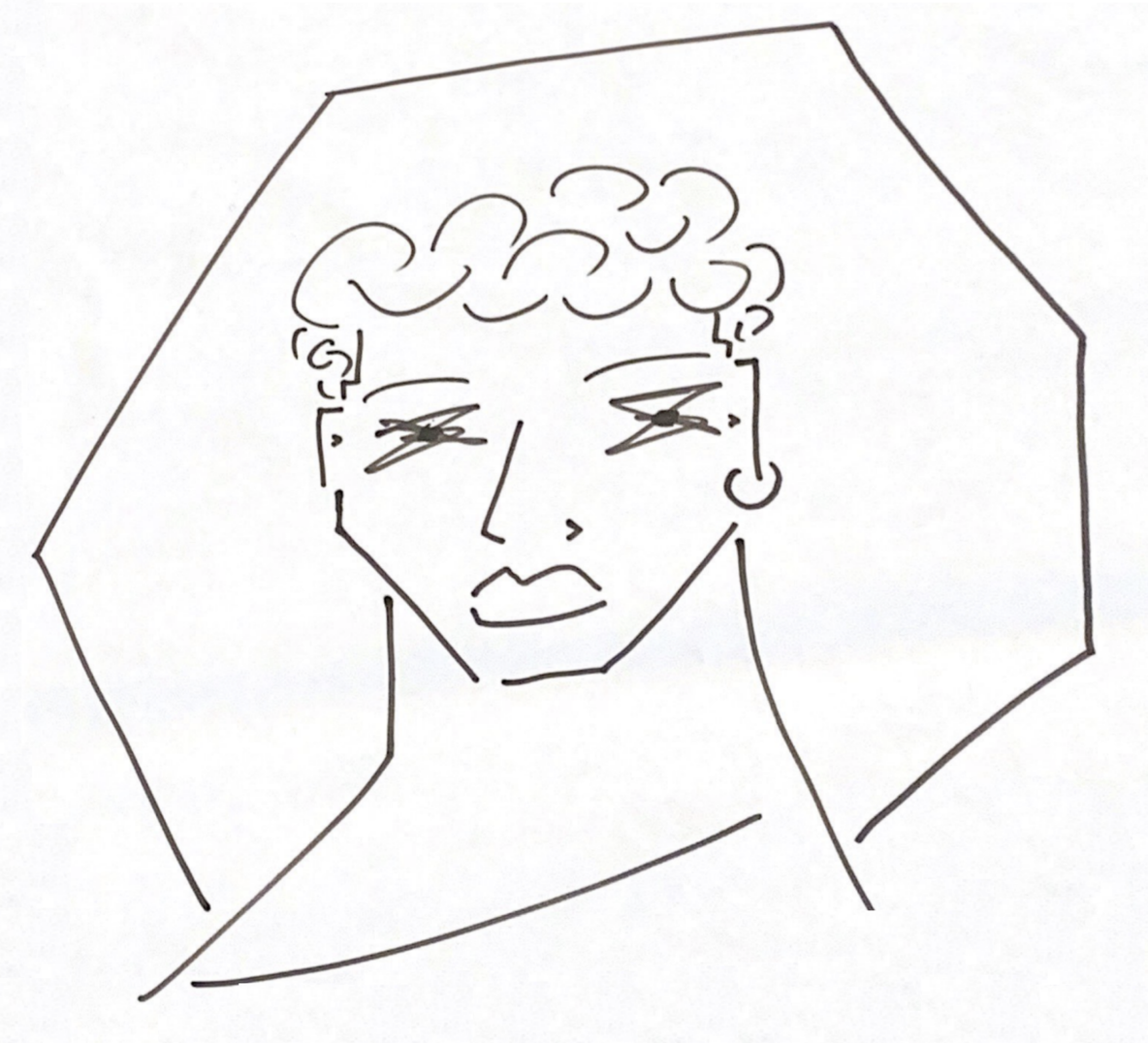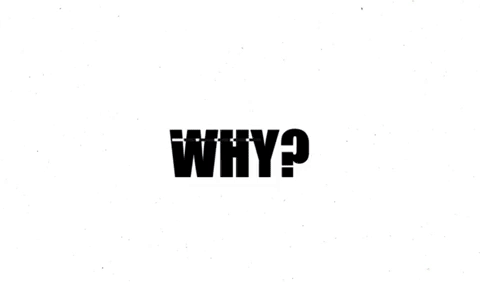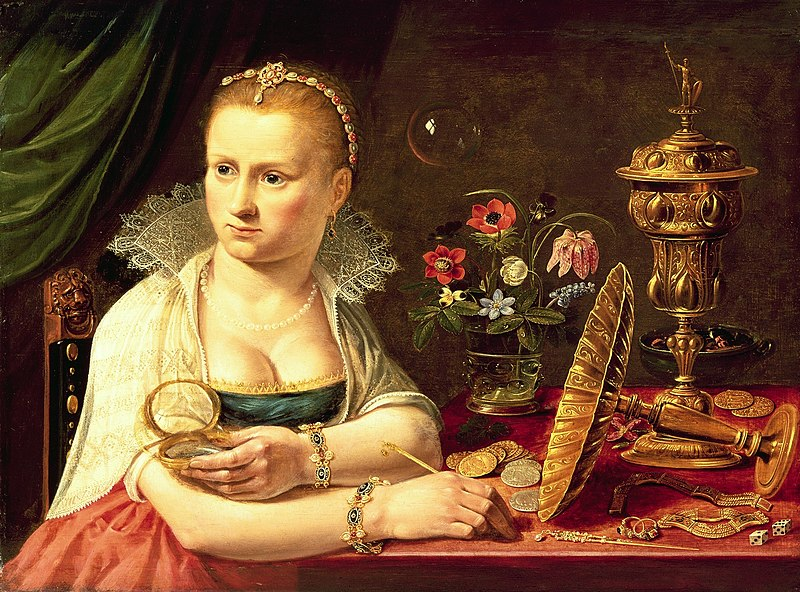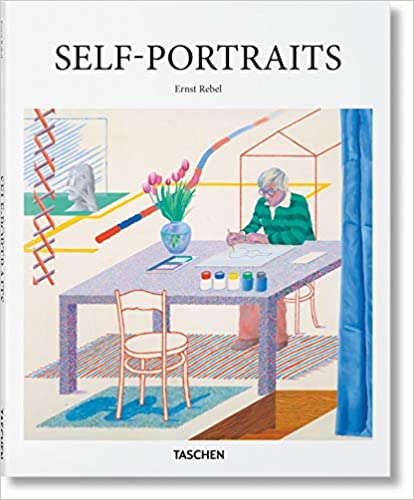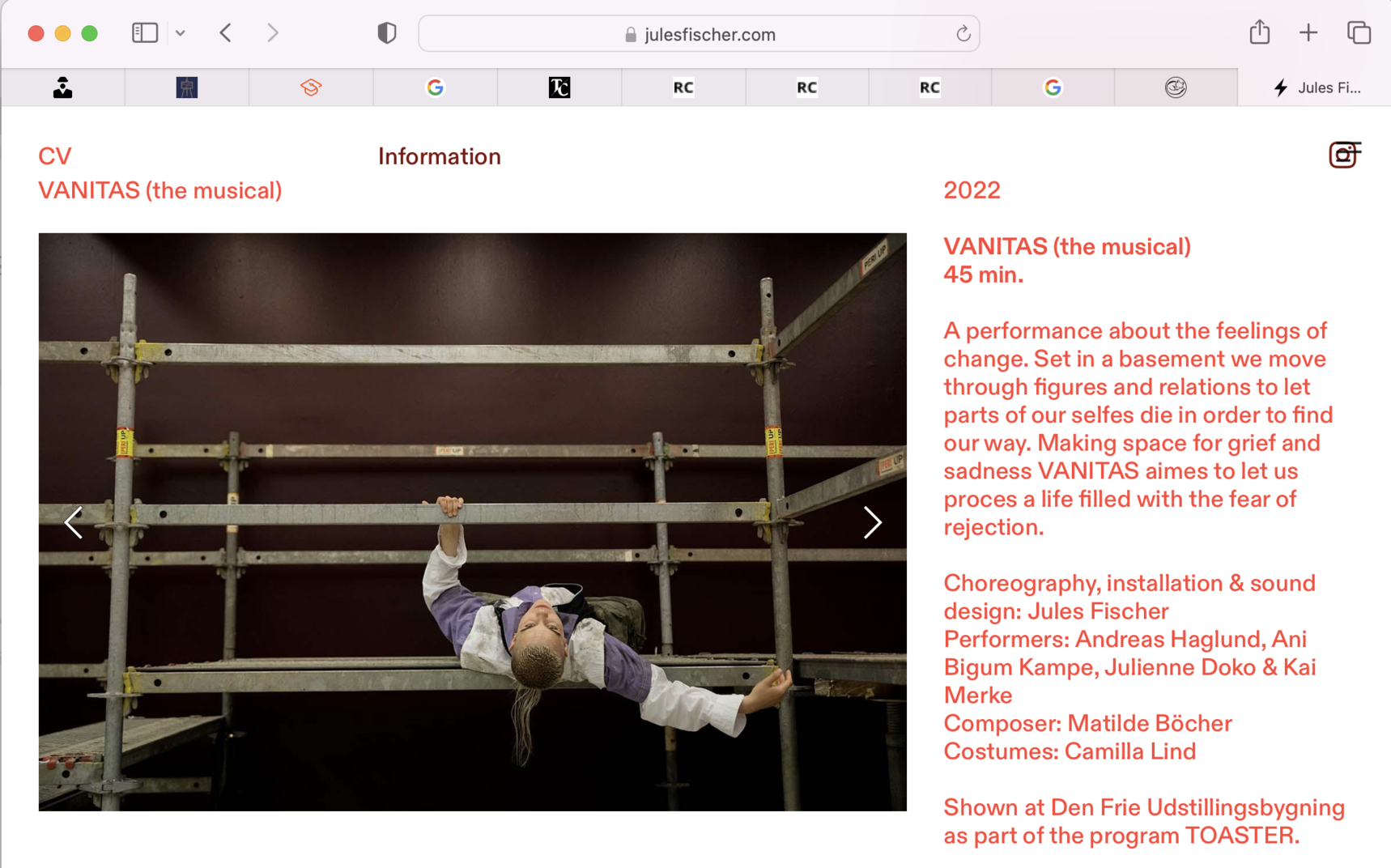I am inspired by the theme vanity. The theme is necessary means to help answer the main research question. In order to create an interactive, participatory performance I needed a theme. When starting my research it seemed like I needed to define a theme in order to have something to work with, in order to prepare, in order to have some control, in order to explore the possibilities of interaction and participation. In the future I see potential for leaving the theme open and allowing for a theme to surface through interaction and participation during the actual performance.
My interested in vanity started from a personal associative exploration of my own vanity. I draw self-portraits quite regularly, I enjoy putting effort in my appearance, I have certain ideals concerning my won body. By diving deeper into this theme I realised that vanity can mean more for certain groups of people as our appearances and that which may seem superficial at first is the outward expression of our identity. Being queer myself, I believe that the outward expression of my queerness might be considered vain, but actually becomes a political statement. It affirms my existence in this world. It claims space. It is seen and cannot be unseen or policed or restricted by others. I believe the same goes for others and potentially even more so for other people outside the scope of the dominant majority within our society.
When researching vanity I came came across the Vanitas genre of still life painting. Particularly one painting by Claara Peeters formed a source of inspiration for creating visual anchors and informing the participatory interventions for _i_C_O_N_i_C_.
Any form of performing or creating art and wanting to be celebrated for it might be an act of vanity. Am I vain because I am an artist? I do not have a yes or no answer to this question, but I do enjoy exploring this question in _i_C_O_N_i_C_.
Allowing the theme Vanity to inform the look, feel and shape of the overall artistic work and its dramaturgical pilars a.k.a. participatory interventions in _i_C_O_N_i_C_ helped answering the main research question: how do I facilitate an interactive method of performance in which intersubjectivity, exchange, ownership, wonder and joy form key parameters? Follow the link in this tiny paragraph if you want to go straight to the conclusion of my research. The answer to the sub question how do I translate the theme, Vanity, into concrete movement material, scenes and experiences in support of intersubjectivity, exchange, ownership, wonder and joy? seems quite straightforward. I translated the theme vanity into concrete movement, scenes and experiences by drawing upon personal experiences, notions, thoughts that came up in conversation with others and taking visual cues and potential actions from Clara Peeters Vanitas self-portrait.
If you want to explore more before heading to the overall conclusion of my research, feel free to do so by using the contents or navigation buttons at the lefthand side top corner of your page.
If you want to engage with me and some of these ideas concerning interaction and participatory art, then go take part in the Part Take Manifesto!
If you have had it with all these words on your screen and welcome a musical distraction, I got you! Follow this link...
This is a self-portrait by me. This single sentence raises two questions:
1. Why a self-portrait?
2. Why attribute it to myself?
A self-portrait is a selfie avant la lettre. Capturing our own image and potentially altering it, by changing some of the features with filters or our drawing skills. Seeing ourselves how we would like to be seen, rather than how we are seen by the outside world. Making ourselves look good, putting time and effort towards our external appearance.
I hold the conviction that vanity is more significant than just worrying about our appearances. It relates to self-expression and contributes to the affirmation of our identities. I signal something about my aesthetics, about certain qualities, perhaps even beliefs and sub-cultures that I wish or believe I belong to.
I would like to draw a parallel between self-portraits and performance based solo's. For a little bit more on self-portraits and more specifically signing by artists click here.
Concerning question number 2: why do we have the need to sign things and gain individual acknowledgement for what we have accomplished? Artists sign their work. Often the focus lies on one individual. The bigger the name, the bigger the audience. Is this another form of vanity? Wanting to be acknowledged as individuals. Wanting to go down in history. Wanting to be remembered. In my practice I am interested in creating with those present in the room during a performance. More on this can be found in the theory section over here.
Now there are multiple ways to dive further into this topic
Layers of vanity in _i_C_O_N_i_C.*
*_i_C_O_N_i_C_ is the name of the piece resulting from my artistic research.
Are these your thoughts: "just give me a short idea of the main take aways from this page" then, in short, I can give you exactly that.
In the above video I have asked my peers from the master's to wear sunglasses, move with their legs turned in, and use ballet arms and épaulement. I asked them to channel their inner-Beyoncé and have an air of arrogance. Somehow, the instruction worked. It became a statuesque game of distant and cool looking people. Associativvely it made me think of how an air of mystery, or distance is something quite alluring. How people who do not seem to care about how they are perceived exude a kind of confidence. At the same time, this might be put on. Are they really that confident? Or do they feel like they can be more extreme because they are wearing sunglasses and therefore automatically become less approachable as people?
What I take form this into my new piece _i_C_O_N_i_C_ is the associations I have with vanity and being somewhat unapproachable. I like the way the statuesque movements work. They feel like a throwback to classical ideas on beauty from Greek and Roman times. The ideal body, the ideal shape, the ideal posture, the ideal image, the ideal form. At the same time I am looking to play around with this. I do not need the movement to be a one on one moving copy of Michelangelo's David. My exploration of turning this statuesque feeling into movement can be seen here.
In the future, I would like to explore this way of moving further with a group of people. For now, I focus on working on myself.
On Friday October 14th 2023, I researched embodying Vanity for at Pictura Dordrecht for a performance on the next day. I was invited to be part of a performance art project called De Leegte (loosely translated into the emptiness). Emptiness associatively fitted the theme vanity. Vanity as a form of emptiness, of superficiality, as not having a soul or having no depth, or perhaps deprived of feelings and only appreciating appearances.
The above two videos are recordings from the rehearsal. I chose a big dramatic coat that would accentuate my movements. I wore sunglasses to create a distance between myself and the viewer. I played with posing and gestures. I tried to find the line between arrogance and self-confidence. I tried to strip naked and let go of any vanity, of material possessions. On the day of the performance, another performer had chosen to strip naked. Which is why I chose not to do so anymore.
In this work I tried to interact with the audience by using hand gestures, stops and sounds, without actually speaking. This exploration relates more directly to my research question.
This small research made me realise that attire and setting are important. The right costume can add to an idea of Vanity, just as the setting can emphasise certain behaviour. I started to think about the artist taking themselves very seriously. There is a certain Vanity in making a group of people watch you move. You take up their time and can 'playfully' indulge in doing so.
It also dawned on me how the rest of the overall arch of the event as a whole influenced my artistic decisions. Someone else, before me, stripping naked made me choose not to do so. To view the event as a whole has consequences for my individual choices.
For _i_C_O_N_i_C_ I take the event into consideration too. I am the last person to perform at the #3 COMMA Festival on a Saturday evening. After my performance there will be a party. I want for my performance to smoothly transition into the party. I want the energy to stay up. I want that which we have built together in my performance to continue and transform into the party. Thinking of the evening as a process helps me make these artistic choices. I have also decided to refrain from taking a bow. Instead I will invite everyone out onto the floor at the end of my piece. I have asked the DJ to transition from the music in my piece to their music.
Using hands and gestures without words to guide the audience was quite a challenge. I do not have a recording from the performance. As the door to the space opened I was standing a few metres in front of the doorway. I took a step and as soon as I heard people walk in behind me, I would stop and gesture with my hands besides my hips for them to stop. A short, staccato, movement repeated twice or three times. When they would have stopped moving I continues walking again. Allowing them to enter the space behind me. After a few steps I would stop and make them stop to by repeating the hand gestures. This would continue until they had filled up half the space behind me. I would gesture for them to stay there and take centre stage in the empty half of the space.
What I learned from this is that I find it nerve wrecking to rely solely on movement to indicate what I want. I also felt very dominant. I was extremely controlling in how I directed them to stop and continue. I realised I prefer a gentler approach. I prefer to use words.
In the future I might come back to this and try to explore this physical dominance further, because there is something there. It is risky, because the moment people choose to ignore you, what do you do?
What I do take from this performance is the time I took for people to look at me. As a mover I prefer to be doing something. Associatively I relate Vanity to wasting time. Making people look for a longer amount of time feels like a possible act of vanity. This came back in another movement exploration that lead to the opening scene for _i_C_O_N_i_C_.
Another thing I take with me is inspiration for the costume. The big black coat has a nice dramatic understated effect. More about my costume choice can be found here.
Clara Peeters
While researching Vanity through self-portraiture I stumbled upon a picture of Clara Peeters' painting called Vanitas Self-Portrait on page 36 of Natalie Rudd's book The Self-Portrait (2021). Peeters was a female painter in the early 17th century. Very little is known about her life. There are 40 paintings by her hand. This work is attributed to her. This painting formed a spring board into the Vanitas art movement, popular in the Netherlands and the low countries in the 17th century.
What is Vanitas?
Vanitas is a subgenre of still life paintings. It originated in the Netherlands. The term comes from the Old Testament and means Vanity as in emptiness or worthlesness in Latin (The National Gallery London). In the 17th century the Netherlands experienced religious termoil. The Spanish Catholic rule had ended and Protestantism surged. Contemplation, modesty and an awareness of the fleeting quality of earthly posessions and pleasures sparked the Vanitas art movement (Hibbitt, 2020).
In Clara Peeters' painting the items on display; gold, jewellery, flowers, a soap bubble, all represent vanity. The bubble pops easily, flowers wilt and the luxury goods are only with you temporarily.
For the opening scene of _i_C_O_N_i_C_ I wear a black dress. In a later scene a bouquet of flowers is created. Both these scenes are inspired by this painting. I am not the only one inspired by vanitas as a theme.
The first video shows the first exploration of embodying vanity with the upper body. It was prompted on February 1st 2023 following a proposal by Bertha Bermudez in her masterclass. Bertha asked us to connect our research to embodiment by picking one word or theme and exploring that. The video was recorded by Thomas Götz.
The next video shows a continued exploration of the embodiment of Vanity. I chose to juxtapose the slow movements with dynamic classical music, as I had done in the first video. To this exploration I added the turning plateau. This plateau is often used to present jewellery or cakes or other items of value. You sometimes see these sorts of turning plateaus in shop windows. I liked the idea of being static while simultaneously turning at a consistent speed. It adds to the idea of vanity because it creates a 'look at me' moment and because of the associations with valuable things being on display. The plateau does limit the range of movement in my legs and adds to the statuesque and quite minimalist movement style. This style is a challenge for me, because I do not usually move slowly and enjoy following the music in terms of dynamics.
In the next two videos I am wearing the costume I will be wearing for the performance. It shows how much the costume influences how the movement is read. I also experiment with different music than I had been using so far. The classical music is replaced by a DJ set.
Somehow, the statuesque and épaulement keep returning when I try and embody vanity. I focussed on the role of the shoulders, collarbones and arms in creating poses. These poses are not static, especially not with the added artificial turning of the plateau. The above exploration became the opening scene for the artistic output of this research - the piece _i_C_O_N_i_C_.
Opening Scene
For the opening scene the performing facilitator is turning on a plateau with a DJ Mix playing and wearing a black dress.
Vanity by association
Turning Plateaus are used to display jewellery, cakes, cars. They present a product and give the onlooker a 360 degree look at the object. These plateaus are not usually used for people. For me putting the performer on display relates to this sense of vanity, of becoming an object, of placing a body in a space and inviting people to look at it from every angle. These plateaus are used to display luxury items. Am I as the performer a luxury? Luxuries are considered vain from the perspective of Vanitas art. I play with the idea of being the object. I also play with asking the audience to feed me grapes. Being fed grapes is considered a luxury. However, in this context it might not be that much of a luxury as the way in which the audience will feed the grapes is open. They might not do it in a way that it establishes the classical hierarchy in status.
The facilitating performer wears three different costumes throughout the piece. The first costume is designed by Ruben Monfrooy. It is a black dress worn for the opening of the performance. It looks like a period dress with a modern twist. It combines a latex body, with a fringed bottom and creates an illusion of having a tiny waist and a large bottom. It alters the shape of the body and how it is read. At the same time it is still clear that the performer's body has features consistent with that of someone assigned male at birth. I am interested in queering the wearing of a dress or perhaps normalising it and relating it to vanity. Getting dressed up in something dramatic that takes up quite some space could be considered an act of vanity. In a different setting it might turn heads and draw attention. Using clothes to pull focus in a room is not uncommon. Dressing up is the final stage of preparing yourself to go out in public and to be seen. An interesting associative link is that to the piece of furniture called a vanity. A little desk with a mirror that would traditionally be used by women to get ready to leave the bedroom and look presentable. Getting dressed and ready to present yourself to others is related to this idea of vanity. The second and third costume are respectively an all white outfit and a long black coat.
Concerning the music, a live recording of Cucut’s DJ Mix performed at the club Nitsa in Barcelona forms the backbone to the piece. When the facilitating performer is turning on the plateau the piece opens with this music. It is later interrupted by the interventions and continues playing whenever it can.
There are several reasons for using this DJ Mix. Vanity can be associated with partying. We go out to be seen and see other. We dress up, we socialise, we dance. This live recording of a DJ Mix evokes this sense of partying as you can hear people on the recording clapping and cheering to the music. The DJ Mix also juxtaposes the aesthetic inspired by Vanitas and Clara Peeters’ self-portrait. Since it sounds modern and fresh. The set sounds inviting and makes it hard to resist wanting to move. It allows for room to play with inviting people to join and asking them to fight that urge.
The physical movement is an attempt at embodying vanity.
Participatory Interventions A.K.A. Dramaturgical Pilars
_i_C_O_N_i_C_ is participatory. The ‘audience’ walks in while I am already turning on a turning plateau. The music will start. After a while I will come off the plateau and start engaging with the audience. There are multiple interventions. I will not go into detail on these interventions and what they entail in a practical sense here, but I will explain how they relate to vanity.
- Ask someone to step onto the plateau and ask the rest of the audience to draw them
- Ask two people to arrange a bouquet of flowers
- Ask 4 people to paint on the facilitating performer with acrylic markers
Vivaldi’s Vedrò con mio diletto (see video to the left). It was originally sung by castrati (men castrated before puberty to maintain their high and pure voices). As a consequence of their castration they would have brittle bones and develop differently. Changing our bodies and appearances to fit certain beauty standards is still a relevant topic today. I associate this with for instance plastic surgery. The song plays while audience members are invited to draw on the body. Thereby changing its outer appearance. Another reason for picking this piece of music is that the voice is often related to ideas and ideals surrounding masculinity and femininity. The way in which we use our voices can be quite distinctive. I have often been told I sound ‘gay’ or have regularly been read as female on the phone. By using this piece of music another layer of self-expression is introduced. Moreover, the song is a love song. In the piece it can be read as a love song towards the self, towards the new exterior, towards the people drawing or perhaps even towards a dream or an ideal. I have struggled with accepting their voice in the past. I had internalised a lot of judgement for it sounding soft or gay or queer or odd because of the accent. I would be afraid to raise my voice and especially afraid to sing. To break through these barriers I started taking singing lessons. My intention as the facilitating performer is to at a certain point be able to sing Vedrò con mio diletto live at this part of the piece. Whether I will sing live at the premiere remains to be seen.
I associate vanity with the outer-appearance, with changing and adapting this appearance, with love or confidence concerning looks and am convinced that all of this is related to questions surrounding our identities. In my case surrounding my gender identity and feeling comfortable within my own skin.
- Ask 1 person who is good with a hammer and 1 who has an eye for composition to hammer my painted clothes to a pallet on the wall
- Ask 2 people to write a gallery opening speech, and play the game telephone with the rest of the audience
- Ask people to help serve drinks
- Ask 1 person to read the opening speech
- Ask everyone who wishes to sign the artwork
- Invite everyone on the dance floor for the party to start
In between these interventions or sometimes during these interventions I will be dancing.
Venue and Setting
The premiere of _i_C_O_N_i_C_ will be at Root Gallery in Rotterdam. This is intentional. The piece needs to be performed in an arts setting such as a gallery or museum. It can be adapted for the theatre, but was made for these other arts spaces. This is because the piece questions the role of the artist, their vanity in creating art, being acknowledged for it and displaying it for others to have to look at it. Sometimes artists can be vain to the point where they leave those encountering their artworks dangling without any clue as to what they are looking at. When is art good art? Is an intriguing question. I am trying to take myself as an artist seriously while simultaneously doing the opposite. I am trying to find levity in art, to find joy and wonder. I am trying to be inspired by moments, interactions and experiences. I am trying to relate myself to the world around me and the people in it.
Perhaps I can do so through art.
The title for the piece _i_C_O_N_i_C_ relates to this idea of being an artist but perhaps not really being one. Especially since I am a trained dancer and philosopher, not a visual artist. I strive to create something iconic, I enjoy having fun with the ambition of creating something that is iconic. While I alos know that I con, I see (_i_C_O_N_i_C_). In our struggle to project a coherent picture outwards of our own identities we are all con artists. Because our identities do not necessarily fit a coherent picture. We are messy, we are more than an image, we are plentiful, we are complex and fragmented and entangled. We are iconic.
Take me back to the start of this page please.
This has made me curious about Embodied Vanity
I want to know more about Clara Peeters and Vanitas
Please distract me!
In Self-Portraits Ernst Rebel (2017) briefly gives an account of how in Antiquity craftsmen would sign their products, but they did not have the status of artists yet. Throughout the middle ages it was considered poor manners to sign pieces of work. Even though, artists who were still on par with craftsmen would try and find inventive ways to sign their work or insert themselves in it. These ways were inventive in that they balanced the ability of being recognised as the artist with knowing ones place in society at large or in relation to the divine.
Some painters would put a self-portrait in their work. The idea of signing an art-piece comes with the desire to be recognised. The desire for fame.
I would say that this desire for fame that comes with signing an artwork, with placing yourself in it, with self-portraiture, is related to vanity.
What makes us interesting or important enough to have this claim to fame? Wanting to set ourselves apart from others? Wanting to be remembered? Wanting to be known?
I told you it would only be a little more. Want to go back to the start of this page? Click here. Want to go somewhere else on this page? Like the embodied vanity? Or the layers of vanity in _i_C_O_N_i_C_? Or want to just know what this page is all about but in short?
Vanitas as a theme
After an online Google search I found VANITAS (the musical) by Jules Fischer. I have not been able to see footage, but because of its theme and for being a performance piece it is worth mentioning it here. Demonstrating that Vanitas is a theme that also inspires other performance makers.
Take me to embodied vanity.
Costumes
The second costume worn in the piece an all white outfit. The colour fits the venue, as everything is black and white, and the white cloth represents a blanc canvas. It is clean and modern. It is functional and suits the intervention where people are invited to draw on the white outfit.The fabric is thick enough to make sure that the markers people use to draw on it will not seep through the material. Once the drawing is done, the performer can easily take it off so the garments can be used and stuck to the wall. The clothes become part of the final collage.
The third costume and final costume is a big black coat. It is a dramatic coat with a black flower on it. Since it is long it functions as a cape and moves as the performer moves. It can remain open, showing body, skin and muscles. It is a play between exposing/being exposed and hiding. Does the coat wear the performer or the performer the coat? It is black to fit the colour scheme and a personal item from Bas’ closet, which might add another layer of significance. Blurring the line between the real, the fake, the ornamented, the honest, the performer, the person, the vain and the profound. The same coat was used in this movement exploration.
Back or forward to:
Layers of vanity in _i_C_O_N_i_C_
The main take aways from this page
The try out, to scroll through it and see the costumes
